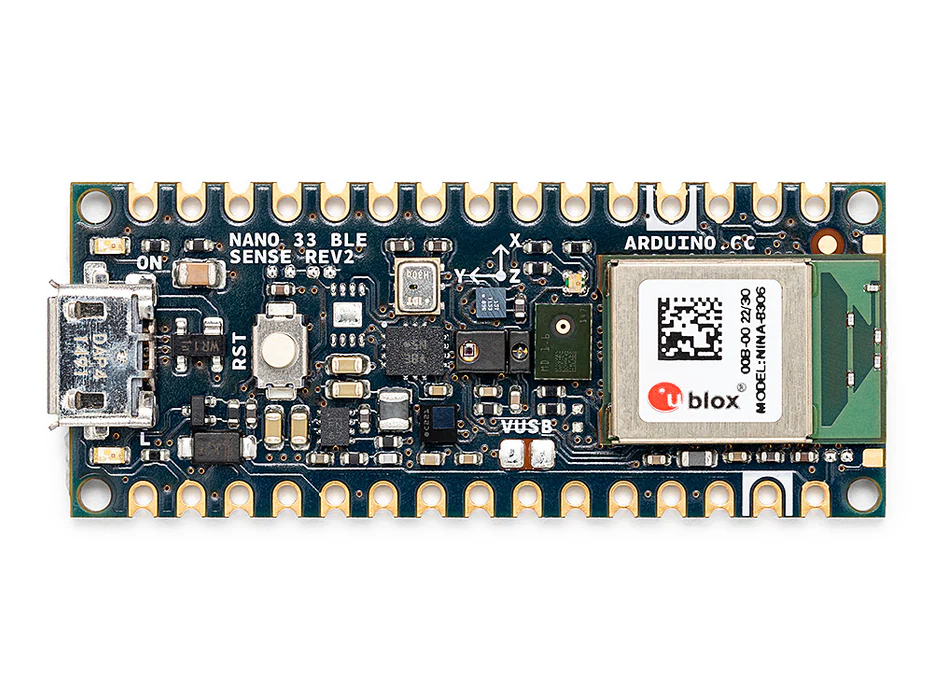
Arduino Nano 33 BLE Sense Rev2
An AI enabled board in the shape of the classic Nano board, with all the sensors to start building your next project right away.
Overview
The Arduino Nano 33 BLE Sense Rev2 is Arduino’s 3.3V AI enabled board in the smallest available form factor with a set of sensors that will allow you without any external hardware to start programming your next project, right away.
With the Arduino Nano 33 BLE Sense Rev2, you can:
- Build wearable devices that using AI can recognize movements.
- Build a room temperature monitoring device that can suggest or modify changes in the thermostat.
- Build a gesture or voice recognition device using the microphone or the gesture sensor together with the AI capabilities of the board.
The main feature of this board, besides the complete selection of sensors, is the possibility of running Edge Computing applications (AI) on it using TinyML. Learn how to use the Tensor Flow Lite library following this instructions or learn how to train your board using Edge Impulse.
Tech specs
|
Microcontroller |
nRF52840 (datasheet) |
|
Operating Voltage |
3.3V |
|
Input Voltage (limit) |
21V |
|
DC Current per I/O Pin |
15 mA |
|
Clock Speed |
64MHz |
|
CPU Flash Memory |
1MB (nRF52840) |
|
SRAM |
256KB (nRF52840) |
|
EEPROM |
none |
|
Digital Input / Output Pins |
14 |
|
PWM Pins |
all digital pins |
|
UART |
1 |
|
SPI |
1 |
|
I2C |
1 |
|
Analog Input Pins |
8 (ADC 12 bit 200 k samples) |
|
Analog Output Pins |
Only through PWM (no DAC) |
|
External Interrupts |
all digital pins |
|
LED_BUILTIN |
13 |
|
USB |
Native in the nRF52840 Processor |
|
IMU |
|
|
Microphone |
MP34DT06JTR (datasheet) |
|
Gesture, light, proximity, color |
APDS9960 (datasheet) |
|
Barometric pressure |
LPS22HB (datasheet) |
|
Temperature, humidity |
HS3003 (datasheet) |
Conformities
Resources for Safety and Products
Manufacturer Information
The production information includes the address and related details of the product manufacturer.
Arduino S.r.l.
Via Andrea Appiani, 25
Monza, MB, IT, 20900
https://www.arduino.cc/
Responsible Person in the EU
An EU-based economic operator who ensures the product's compliance with the required regulations.
Arduino S.r.l.
Via Andrea Appiani, 25
Monza, MB, IT, 20900
Phone: +39 0113157477
Email: support@arduino.cc
Documentation
Learn more
Get Inspired

Learn how to build a complete HMI with Arduino that will allow you to interact with your projects in an intuitive and visual way.

OPC Unified Architecture – OPC UA in short – is a cross-platform, open-source machine-to-machine communication protocol for industrial automation. It was developed by the Open Platform Communications (OPC) Foundation and is defined in detail in the IEC 62541 standard. With the release of the Arduino_OPC_UA library we enable users to convert any product from our Arduino Opta range into an OPC UA-enabled device. Step-by-step guide to setting up OPC UA on Arduino Opta It’s as simple as uploading a single sketch onto your Opta and connecting it to an Ethernet network. Once uploaded, the OPC UA firmware exposes the Arduino Opta’s analog and digital inputs, the user button and LED (only Arduino Opta WiFi), as well as its relay outputs as properties that can be read from or written to using OPC UA. OPC UA communication is performed using OPC UA binary encoding via TCP sockets. Arduino_OPC_UA is a port of the Fraunhofer open62541 library implementing IEC 62541 in highly portable C99 for both Windows and Linux targets. One serious challenge during the porting of open62541 was to decide on sensible tradeoffs concerning RAM consumption, as using OPC UAs full namespace zero (NS0) requires up to 8 MB of RAM while the STM32H747 powering the Arduino Opta has a total of 1 MB of SRAM to offer – some of which already allocated by the the Arduino framework for the Arduino Opta. Expand functionality with Arduino Opta Modules and OPC UA integration Additionally, Arduino_OPC_UA supports the automatic discovery, configuration and exposure as OPC UA objects of the recently released Arduino Opta expansion modules. Currently three different expansion modules exist: Arduino Opta Analog Expansion (A0602), Arduino Opta Digital Expansion with electro-mechanical relay outputs (D1608E), and with solid-state relay outputs (DS1608S). During system start-up, the Arduino Opta’s expansion bus is queried for connected expansion modules and automatically configures them and
FAQs
What is the difference between Rev1 and Rev2?
There has been some changes in the sensor between both revisions:
- Replacement of IMU from LSM9DS1 (9 axis) for a combination of two IMUs (BMI270 - 6 axis IMU and BMM150 - 3 axis IMU).
- Replacement of temperature and humidity sensor from HTS221 for HS3003.
- Replacement of microphone from MP34DT05 to MP34DT06JTR.
Additionally some components and the changes have been done in order to improve the experience of the users:
- Replacement of power supply MPM3610 for MP2322.
- Addition of VUSB soldering jumper on the top side of the board.
- New test point for USB, SWDIO and SWCLK.
Do I need to change my sketch used in the previous revision?
For sketches done using the libraries like LSM9DS1 for the IMU or HTS221 for the temperature and humidity sensor, for the new revision this libraries must be changed to Arduino_BMI270_BMM150 for the new combined IMU and Arduino_HS300x for the new temperature and humidity sensor.






